Review: Google Pixel 2 XL
Nov 15, 2017, 2:00 PM by Eric M. Zeman
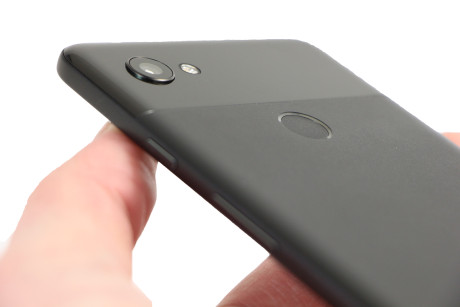
The Pixel 2 XL is Google's flagship Android handset. Though the software is more important than the hardware, the Pixel 2 XL is a big statement from Google. This high-end handset contains top components that deliver competitive performance across the board. The camera is particularly impressive, allowing the Pixel to go toe-to-toe with the best from Apple, LG, and Samsung. Here is Phone Scoop's in-depth review.
Is It Your Type?
The Pixel 2 XL from Google is a top-of-the-line smartphone that includes a powerful camera, a large display, a metal design, and the pure Google experience that many Android fans relish. If you're seeking the most Androidful Android phone, the Pixel 2 XL delivers the goods.
Background
Google releases a new set of Google-branded smartphones each fall. The idea is to offer Android enthusiasts ideal hardware to showcase the best of Google's software. This year's Pixel 2 and Pixel 2 XL run the same software, but straddle the currently evolving smartphone form factor. Where the Pixel 2 is slightly smaller and relies on the older 16:9 aspect ratio display, the Pixel 2 XL is larger and moves to the 2:1 (18:9) aspect ratio screen that's being adopted by today's most popular flagships. HTC makes the Pixel 2, while LG makes the larger Pixel 2 XL.
Body
Google has a decidedly simple idea of what hardware should look like. No phone designed by Google has ever been particularly striking in its appearance. This year's Pixel 2 and Pixel 2 XL feel even more generic to me. The Pixel 2 XL does everything possible to make you forget you're even holding a high-end piece of hardware and instead help you focus on the Googleyness behind the screen. That's the point.
The 2 XL is a monolithic device. It's tall, commanding, a doorway into the void. Its dimensions are awkward. The 2 XL stretches the industrial design of last year's Pixel and merges it with the 2:1 screen shape overtaking the market now. The result is a handset that bears the gawky look of a teenager who has suffered some uneven growth spurts.
The phone's face is black glass from top to bottom, while the phone's back is covered by a smaller black glass panel. A one-piece metal chassis forms the side edges and most of the rear panel. The metal is available in black or white (the latter being referred to as the "panda" variant). I really liked the texture of the metal on last year's phone. This year, the painted metal has a rougher texture that I'm not sold on.
At 6.22 inches, the 2 XL qualifies as a Really Tall Phone. To make room for the stereo speakers, the phone has a visible forehead above — and visible chin below — the display. The phone is also more than 3 inches wide. Thanks in part to the ~2:1 shape, it feels like a surfboard in your hand. I'm glad it's under 8mm thick, and thank goodness the weight isn't unbearable. It may simply be too much phone for some people. The smaller Pixel 2 might be a better option if you have small hands. Similar to the elongated Note8, the Pixel 2 XL is uncomfortable to carry around in your jeans pocket. It becomes a leg-poking plank along your thigh, and the experience gets old fast when you get poked every time you get into and out of a car. Putting a case on it only makes it worse.
The fit and finish of the phone's materials and manufacture are not in question. The external glass and metal components are assembled with precision. It feels like the high-end phone that it is.
Curved glass covers the entire front surface. The edges of the 2 XL's glass panel are curved more than on most phones. There are no physical buttons marring the glass.
Speaker Housing
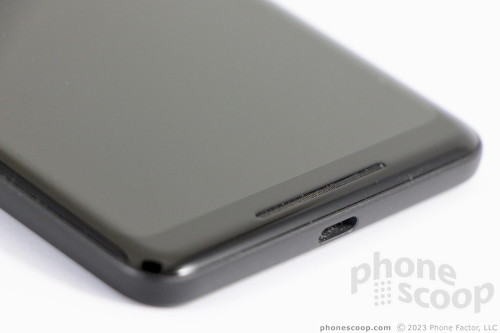
The screen lock and volume buttons on the right edge have excellent profiles. Google positioned the screen lock button near the top and put the volume toggle in the middle. I prefer the lock button to be the lower of the two. Positioning aside, both buttons have perfect travel and feedback. You'll find the SIM tray on the left edge of the 2 XL, but you won't find support for memory cards.
The USB-C port is on the bottom. There's no headphone jack, a first for a Nexus/Pixel phone. Google includes an adapter in the box, but not a set of USB-C headphones.
USB-C
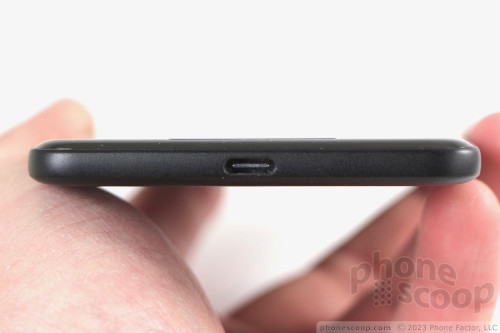
There is some good news: the 2 XL is water resistant to 3 feet (for 30 minutes). That means your phone can handle a run in the rain and an accidental dunk in the pool.
The rear panel is about 80% metal and 20% glass. The glass houses the camera module, flash, and sensors, most of which are plainly visible. The glass is the big reason the phone's chassis has no antenna lines, something I appreciate. The camera sticks out a bit from the surface of the glass. It has a dark, reflective rim that calls it out visually. The dual-LED flash also has a similar rim. The fingerprint reader is located perfectly on the rear panel. It's indented a bit and I had no trouble finding and using it without looking. If you have small hands, you might find it's a bit high up. The metal/glass chassis mean you have no access to the internal battery.
Fingerprint Reader
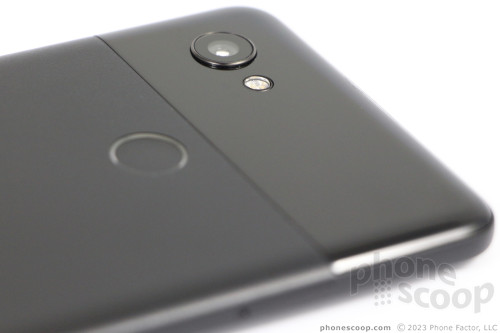
Each year I'm a bit conflicted on the design of Google's signature devices and this year is no different. There are things I like about the Pixel 2 XL (materials, quality) and things I don't (paint, size/shape). The Pixel itself is supposed to disappear as you experience the Google within. In that respect, it almost succeeds.
Module
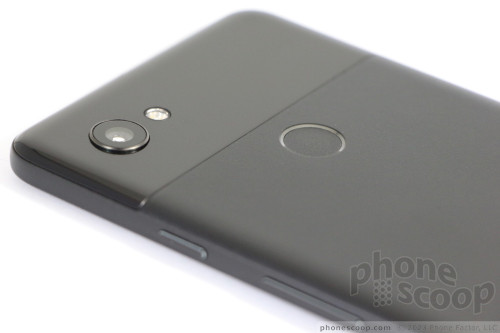
Screen
We've already had a lot to say about the Pixel 2 XL's display. For the full story, please read our earlier impressions. We're reassessing the phone now because Google has made good on its promise to deliver a software update to resolve some of the problems we experienced when the phone first launched.
The Pixel 2 XL's screen measures 6 inches across the diagonal with 2,880 by 1,440 pixels and a 2:1 aspect ratio. The screen is an OLED panel, as opposed to LCD, and LG protects it with Gorilla Glass 5. Before the update, the 2 XL's screen gave us lots of pixels, bright light, and accurate colors. It also gave us horrendous blue shift and the threat of burn-in.
The quad HD+ pixel count matches today's best phones and produces the sharpest, cleanest experience available.
Brightness is now generally lower as you use the phone. This is one of the methods employed by Google to negate the potential for burn-in. You can adjust screen brightness however you wish, but if you use the auto-brightness tool the screen will more aggressively keep brightness at a lower setting. I sometimes found myself bumping the brightness up, particularly when indoors. Google says it is doing other things to prevent burn in, such as hiding the menu keys. It must be quite conservative about this, because I didn't notice any difference in behaviour. The idea is to reduce the amount of time anything persists on the display, which is what actually leads to burn-in. We can only assume these measures will produce the needed protection over time. I haven't seen any hint of burn-in since first assessing the phone.
Display Settings
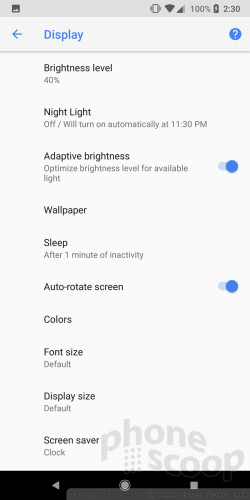
The Pixel 2 XL now offers three screen color settings: boosted, natural, and saturated. The natural setting is the one that caused all the complaints, as it shows color at its most accurate, at the expense of any wow factor. To some, this natural setting looks dull. The boosted mode improves saturation by just 10%. It's hardly noticeable unless you do direct comparisons between them. The new "saturated" setting boosts color by an unspecified larger degree and makes the display "pop" more. There is a definite difference between boosted and saturated. If you like the way Samsung displays generally look, you'll probably prefer this last setting more than the others. I'm fine with the screen on the boosted mode, with colors exaggerated just a little.
Display Color Options
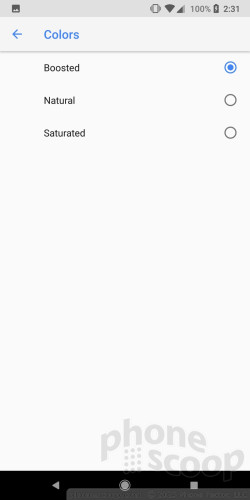
Google could not fix the Pixel 2 XL's blue shift issue with viewing angles, since it's strictly a hardware issue. It's still among the worst I've seen. I find it distracting and it bugs me. It may not bug you at all.
In sum, the screen is not as good as I want it to be for a device this costly. It's not a terrible screen, and likely not a dealbreaker for many, but it should perform better considering the price of this phone.
Signal
Verizon is the only carrier that to sell the Pixel 2 XL directly, but the phone is available unlocked from Google with support for a generous number of LTE bands. For example, it covers T-Mobile's Band 66, though not Band 71. You can also run the phone on Google's Project Fi MVNO, which is essentially T-Mobile.
I tested the Pixel 2 XL on AT&T, T-Mobile, and Verizon in the metro NYC area and was generally pleased with the results on all three carriers.
The phone maintained a connection each network in strong and weak coverage areas alike. I had no trouble connecting calls under even the poorest network conditions. The phone held onto calls during lengthy highway drives without issue.
Data performance was excellent. With support for Cat 15 LTE, the Pixel 2 XL is one of the quicker devices I've tested in recent months. It easily supports media streamed via LTE. For example, I didn't run into any trouble with YouTube, Spotify, or even Netflix.
Sound
The Pixel 2 XL is a better voice phone than the smaller Pixel 2. To start, the earpiece produces dramatically more volume. I didn't have any trouble hearing calls in noisy spaces such as coffee shops and city streets, even with the volume at mid levels. Clarity ranged from good to great. The earpiece didn't suffer from distortion when cranked, and voices generally had a warm timbre when emanating through the speaker. Those I spoke to through the Pixel 2 XL said I sounded excellent.
The speakerphone is punchy and clear. I was easily able to hear calls in a moving car. You have to put the volume all the way up, yet it remains free of distracting distortion.
Ringers and alerts are very loud. The vibrate alert did very well.
The phone has stereo speakers and I was pleased with their performance. Again, the 2 XL outperforms the 2 by just a bit here. The speakers produced more balanced sound. You can easily fill a small room with sound at max volume. The speakers make the 2 XL a great personal entertainment device.
Battery
The Pixel 2 XL has a good-sized 3,250 mAh battery under the metal skin. On most days, the phone is a battery champ. It will push from breakfast to bedtime and beyond. I can't complain at all, as I was rarely able to drain the phone's battery fully. The Pixel 2 XL should get most people through a full day without issue.
The Pixel 2 XL supports Quick Charge 3.0 and it ships with a high-speed charger. Plug the phone in for as little as 20 minutes and you'll gain several hours of additional uptime. The mostly-metal rear panel precludes the phone from supporting wireless charging.
Bluetooth, GPS, NFC, WiFi
The Pixel 2 XL connected to a wide range of accessories. It had no trouble managing Bluetooth headphones for calls or music. Calls made via Bluetooth headsets were good, and sometimes borderline excellent. Calls routed to my car's hands-free system were above average. Music sounded very good through Bluetooth headphones and speakers.
The GPS radio was quick and accurate. The Pixel 2 XL often pegged me within seconds and was accurate to within about 10 feet. The phone was a fine navigation tool, as the fast data performance and GPS accuracy meant it was spot-on when driving from Point A to Point B.
With NFC aboard, you can use the Pixel 2 XL to make mobile payments via Android Pay. I found it worked well. The NFC radio also helps pairing with some Bluetooth accessories.
The 2 XL's WiFi radio is very, very good.
Comments
Project Fi...


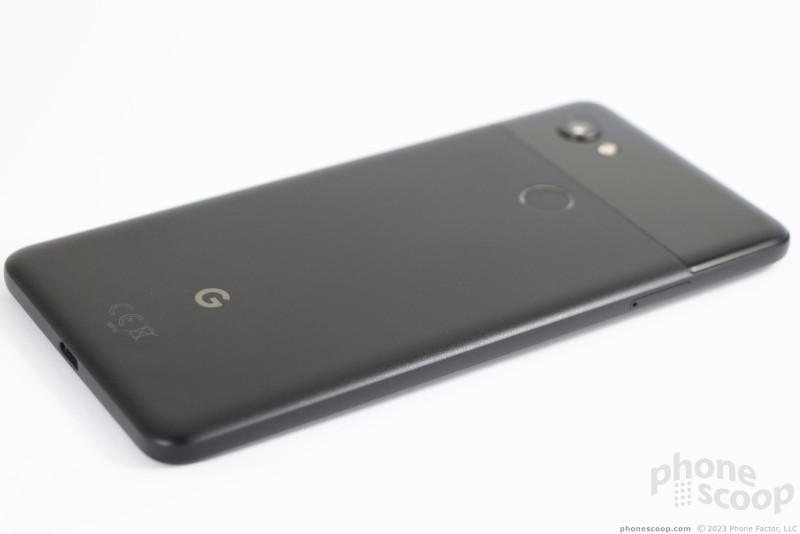

















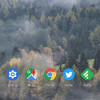 Hands On with Android P
Hands On with Android P
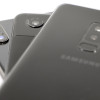 Smartphone Camera Shoot-Out: iPhone X, Pixel 2 XL, Galaxy S9+
Smartphone Camera Shoot-Out: iPhone X, Pixel 2 XL, Galaxy S9+
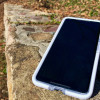 Review: Tech 21 Evo Check Case for Pixel 2 XL
Review: Tech 21 Evo Check Case for Pixel 2 XL
 Holiday Gift Guide 2017
Holiday Gift Guide 2017
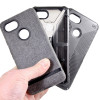 Review: UAG, Speck, and Incipio Cases for the Google Pixel 2 XL
Review: UAG, Speck, and Incipio Cases for the Google Pixel 2 XL
 Google Pixel 2 XL
Google Pixel 2 XL



